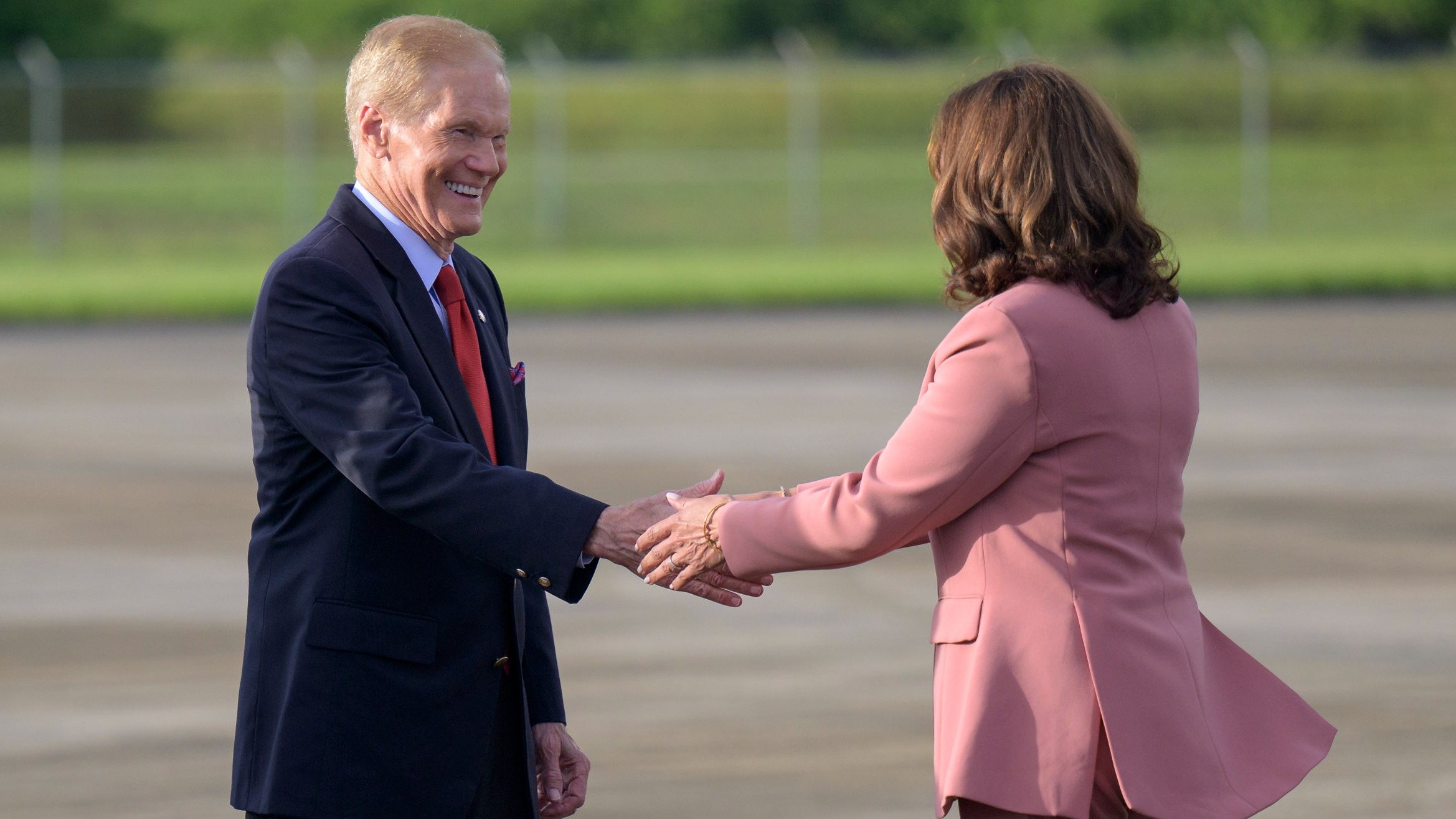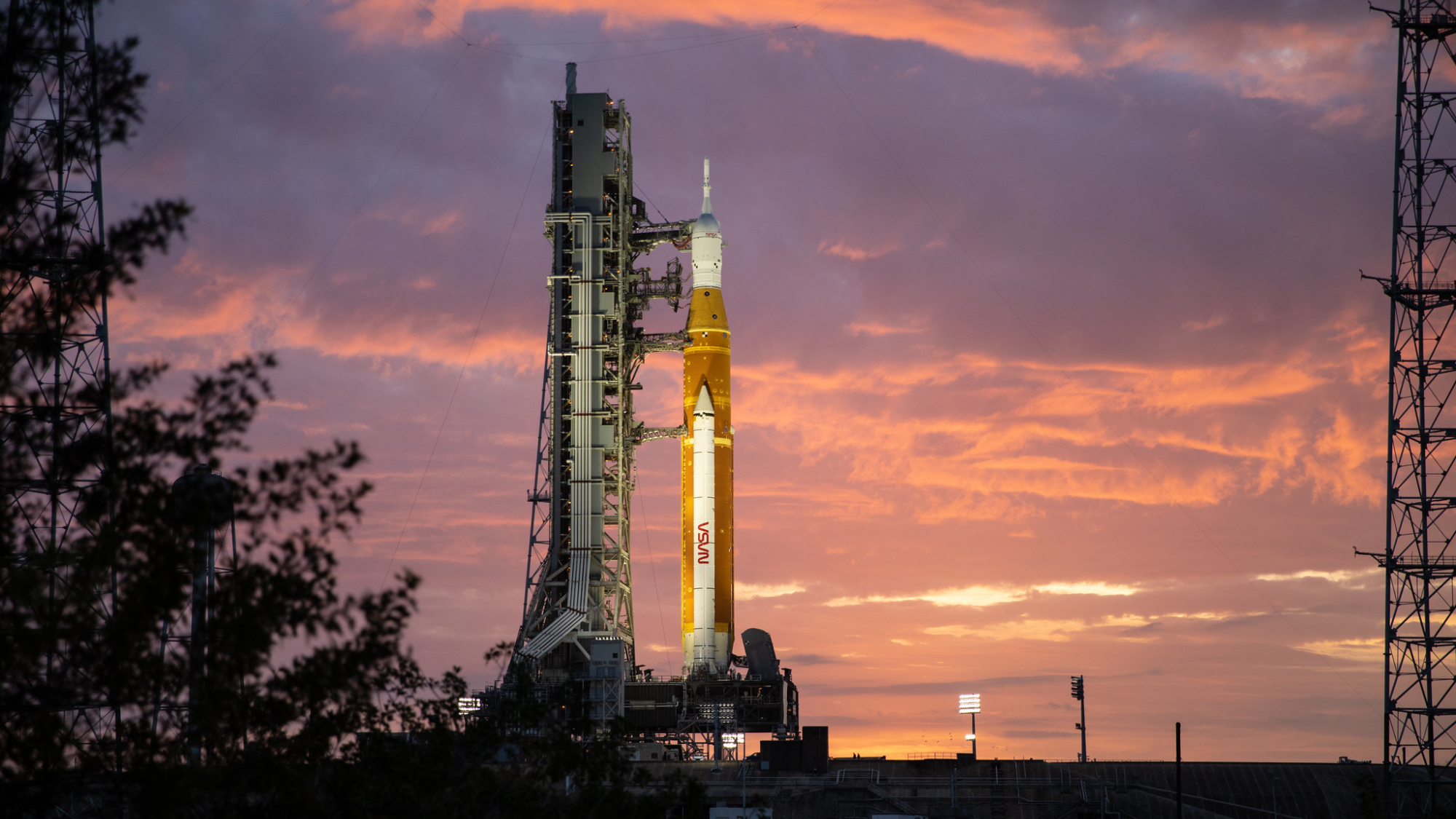VP Harris and NASA chief unconcerned by Artemis 1 launch delay
"You don't want to light the candle until it's ready to go."
Top U.S. space officials urged patience after NASA's mega moon mission scrubbed Monday (Aug. 29).
Vice President Kamala Harris, who is also chair of the National Space Council, told reporters on site for the Artemis 1 launch at NASA's Kennedy Space Center (KSC) in Florida that it took decades of work to get this far. (Harris' office told Space.com in an exclusive Thursday, Aug. 25 that the Vice President would attend the launch attempt.)
"Today is very much about showing the great work that happened here," Harris said in brief remarks this morning after meeting with several NASA astronauts outside a KSC building. Minutes before, Artemis 1 was scrubbed due to an engine cooling issue with the Space Launch System megarocket. A new launch date is still being determined; the earliest possible opportunity is Friday (Sept. 2).
Related: NASA's Artemis 1 moon mission explained in photos

While we hoped to see the launch of Artemis I today, the attempt provided valuable data as we test the most powerful rocket in history. Our commitment to the Artemis Program remains firm, and we will return to the moon.August 29, 2022
Harris framed the delay of the moon mission's first launch attempt as an opportunity to showcase the contribution of the estimated 30,000 workers that contributed to the mission, most especially those at NASA.
The Vice President said the work on Artemis 1 to date was a tribute to "these exceptional public servants, these exceptional skilled professionals who have the ability to see what is possible, and what has never been done before."
Speaking on NASA TV Monday, agency administrator Bill Nelson referenced his own launch experience to say that delaying liftoff to the moon was a wise decision. Nelson flew aboard a space shuttle mission, STS-61-C, that scrubbed four times before its successful liftoff on Jan. 12, 1986, he said.
Get the Space.com Newsletter
Breaking space news, the latest updates on rocket launches, skywatching events and more!
Related: NASA's Artemis 1 moon mission: Live updates
More: 10 wild facts about the Artemis 1 moon mission
"You can't go; there are certain guidelines," Nelson added of the Artemis 1 scrub. "I think it's just illustrative that this is a very complicated machine, a very complicated system. All those things have to work, and you don't want to light the candle until it's ready to go."
Nelson said that with test flights, halting launches like this is "just part of the space business," and emphasized Artemis 1 is meant to reduce risk for future human missions that will use the same SLS rocket and Orion spacecraft.
"We are stressing and testing this rocket and the spacecraft in a way that you would never do with a human crew on board. That's the purpose of a test flight," he said, noting NASA would "work the problem" to get ready for the next launch attempt.

Artemis 1 is tasked with launching an uncrewed Orion spacecraft around the moon for an endurance mission lasting approximately 40 days in space depending on when it launches. NASA's aim is to test the system beyond what would be expected for a human launch, to make sure the rocket and spacecraft can safely carry humans.
The agency's Artemis moon program timelines will in part depend on a successful launch, flight and splashdown for Artemis 1. Four astronauts (who have yet to be named) will fly on Artemis 2 around the moon no earlier than 2024. If that goes to plan, NASA hopes to land a crew at the moon's south pole on Artemis 3 in 2025 or 2026.
Editor-in-Chief Tariq Malik contributed reporting to this story from Cape Canaveral, Fla.
Follow Elizabeth Howell on Twitter @howellspace. Follow us on Twitter @Spacedotcom or Facebook. Space.com
Join our Space Forums to keep talking space on the latest missions, night sky and more! And if you have a news tip, correction or comment, let us know at: community@space.com.

Elizabeth Howell (she/her), Ph.D., was a staff writer in the spaceflight channel between 2022 and 2024 specializing in Canadian space news. She was contributing writer for Space.com for 10 years from 2012 to 2024. Elizabeth's reporting includes multiple exclusives with the White House, leading world coverage about a lost-and-found space tomato on the International Space Station, witnessing five human spaceflight launches on two continents, flying parabolic, working inside a spacesuit, and participating in a simulated Mars mission. Her latest book, "Why Am I Taller?" (ECW Press, 2022) is co-written with astronaut Dave Williams.
- Tariq MalikEditor-in-Chief









